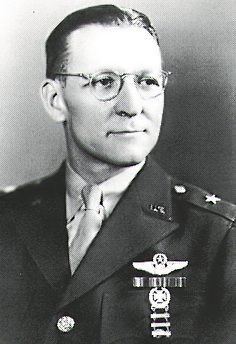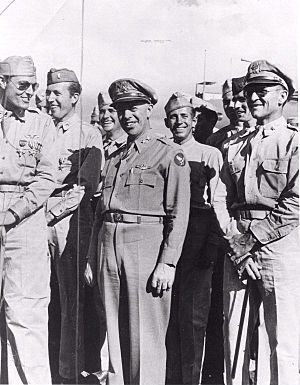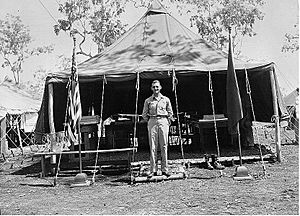Kenneth Walker facts for kids
Quick facts for kids
Kenneth Newton Walker
|
|
|---|---|

Brigadier General Kenneth N. Walker
|
|
| Nickname(s) | Ken |
| Born | 17 July 1898 Cerrillos, New Mexico |
| Died | 5 January 1943 (aged 44) Rabaul, New Britain |
| Places of Burial (markers only) |
Arlington National Cemetery
Manila American Cemetery, Philippines |
| Allegiance | |
| Service/ |
|
| Years of service | 1917–1943 |
| Rank | |
| Service number | 0-12510 |
| Commands held | V Bomber Command 18th Pursuit Group 9th Bombardment Squadron 11th Bombardment Squadron |
| Battles/wars | World War II |
| Awards | Medal of Honor Distinguished Service Cross Silver Star Legion of Merit Purple Heart |
Kenneth Newton Walker (born July 17, 1898 – died January 5, 1943) was a United States Army aviator. He became a Brigadier General in the United States Army Air Forces. He was very important in shaping how air power was used in wars. After he died, he was given the Medal of Honor for his bravery in World War II.
Walker joined the United States Army in 1917, during World War I. He learned to fly and became a flying teacher. After the war ended, he became a regular officer in the Army in 1920. He later went to the Air Corps Tactical School in 1929 and then taught there.
He believed that air forces should be their own separate group, not controlled by other parts of the military. He strongly supported using strategic bombing. This meant bombing important enemy targets far away to win wars. He was part of a group called the "Bomber Mafia" who thought bombing was the most important part of air warfare. He also believed that fighter planes could not stop a determined bombing attack.
Walker helped create the idea of "industrial web theory" at the Air Corps Tactical School. This idea focused on carefully bombing specific factories and industries that were vital to the enemy's war effort. Before the United States entered World War II, Walker was one of four officers who created the AWPD-1 plan. This plan was a guide for how the air war against Germany would be fought. It called for building a huge air force to win the war through strategic bombing.
In 1942, Walker became a brigadier general and moved to the Southwest Pacific. There, he led the V Bomber Command of the Fifth Air Force. This area did not have many strategic targets, so bombers were used to cut off enemy supplies and help ground troops. This led to disagreements between Walker and Lieutenant General George C. Kenney about the best way to use bombers.
Walker often flew dangerous combat missions over New Guinea. For his bravery, he received the Silver Star award.
Contents
Early Life and Military Start
Kenneth Walker was born in Los Cerrillos, New Mexico in 1898. His family later moved to Denver, Colorado. He went to different schools in Denver and Omaha, graduating in 1915. He also studied business administration for a short time.
Walker joined the United States Army in Denver on December 15, 1917. He trained to be a pilot at the University of California and at Mather Field. On November 2, 1918, he earned his Aircrew Badge and became a temporary second lieutenant in the United States Army Air Service.
After his training, he became a flying instructor at Brooks Field in Texas. He also taught at Barron Field and Fort Sill. For four years, he worked at Post Field as a pilot, instructor, and supply officer.
His Death in Battle
On January 5, 1943, General Walker was leading a bombing mission during the day over Rabaul. His plane was shot down, and he was killed. For his extreme bravery and leadership on this mission, he was given the Medal of Honor.
His body and the wreckage of his aircraft were never found. Because of this, his name is listed on the Tablets of the Missing at the Manila American Cemetery and Memorial in the Philippines. This memorial honors service members who went missing in action or were buried at sea in the Southwest Pacific. On December 7, 2001, a special marker was placed for him at Arlington National Cemetery in the United States. This gives his family a place to remember him.
Remembering General Walker
In January 1948, an air base in Roswell, New Mexico, was renamed Walker Air Force Base to honor him. The base was closed in 1967. There is also a building called Walker Hall at Maxwell Air Force Base. Inside, the Walker Air Power Room is named after him. This building is home to the Air Force Doctrine Development and Education Center.
The Walker Papers is a special program for Air Force Fellows. Each year, it gives the Walker Series award to the top three research papers. These papers are written by Air Force Fellows. The award recognizes their important research on air and space power. It also honors how their work helps US strategic policy.
Related pages
Images for kids
-
Senior Allied commanders in New Guinea in October 1942. Left to right: Mr. Frank Forde; General Douglas MacArthur; General Sir Thomas Blamey; Lieutenant General George C. Kenney; Lieutenant General Edmund Herring; Brigadier General Kenneth Walker.






